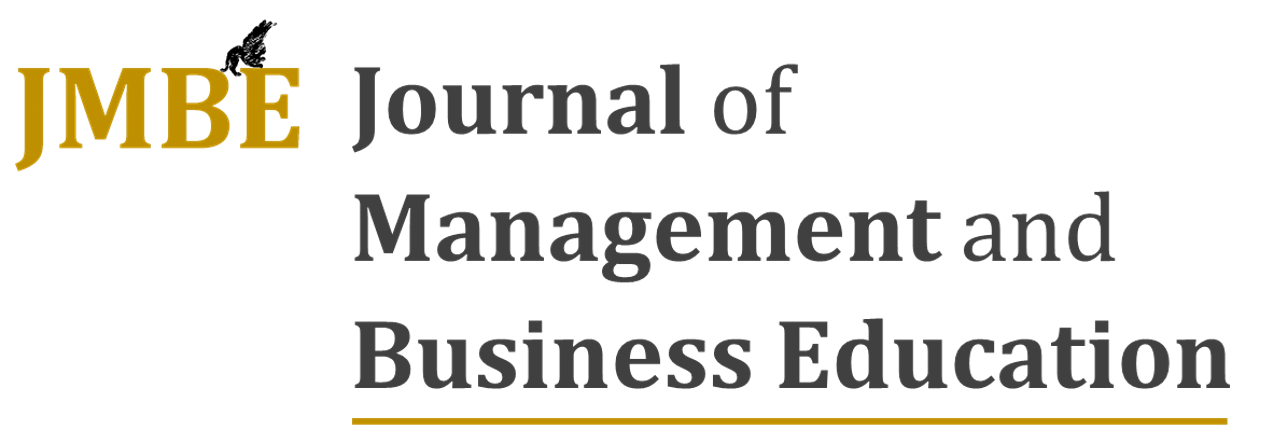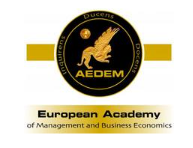When the setting is right, ideas will flow- a business class case study
DOI:
https://doi.org/10.35564/jmbe.2019.0006Keywords:
creativity inducing environments, creative thinking tools, techniquesAbstract
Generating new ideas is the call of the day as teachers seek to differentiate the students’ capabilities in unique and creative ways preparing them to face uncertainties in the work environment. A critical component of this process is to ensure that students are taught how to come up with new ideas, and making the classroom environment conducive to creative thinking. This study offers an observation of a business classroom experience that led to highly effective flow of ideas through the use of tools and techniques that create a safe environment for students, which can also be applied to any organizational setting. Participants were first taught to develop the rules of engagement required for a safe environment and then were trained in utilizing different creative thinking tools. The impact on the participants’ creative and innovative abilities as evidenced in their final design sprint project was found to be significant. The implications of these findings for management and leaders in education and organizational settings are highlighted.
Downloads
References
Aleksic, D, Cerne, M, Dysvik, A. & Skerlavaj, M, (2016) 'I want to be creative, but … preference for creativity, perceived clear outcome goals, work enjoyment, and creative performance', European Journal of Work & Organizational Psychology, Vol. 25, No. 3, pp:363-383.
https://doi.org/10.1080/1359432X.2015.1077809
Baker, D. F. & Baker, S.J. 2012. To "Catch the Sparkling Glow": A Canvas for Creativity in the Management Classroom, Academy of Management Learning & Education Vol. 11, No. 4, pp: 704-721
https://doi.org/10.5465/amle.2010.0003
Betancaur, J. (2017) The Art of Design Thinking, Brick Startup
Bornay-Barrachina, M & Herrero, I. (2018) 'Team Creative Environment as a Mediator Between CWX and R&D Team Performance and Moderating Boundary Conditions', Journal of Business & Psychology, Vol. 33, No. 2, pp:311-323.
https://doi.org/10.1007/s10869-017-9495-8
Chua, R.Y.J. (2013) 'The Costs of Ambient Cultural Disharmony: Indirect Intercultural Conflicts in Social Environment Undermine Creativity', Academy of Management Journal, Vol. 56, No. 6, pp:1545-1577.
https://doi.org/10.5465/amj.2011.0971
Coelho, F. & Augusto, M. (2010) 'Job Characteristics and the Creativity of Frontline Service Employees', Journal of Service Research, Vol. 13, No. 4, pp:426-438.
https://doi.org/10.1177/1094670510369379
Coughlan, T. & Johnson P. (2008) 'An Exploration of Constraints and End User Development in Environments for Creative Tasks', International Journal of Human Computer Interaction, Vol 24, No. 5, pp: 444-459.
https://doi.org/10.1080/10447310802142185
Davilo, A & Ditillo, A. (2017) 'Management Control Systems for Creative Teams: Managing Stylistic Creativity in Fashion Companies', Journal of Management Accounting Research Vol. 29, No. 3, pp: 1-39.
https://doi.org/10.2308/jmar-51806
de-Haan, J, Naus, F. & Overboom, M. (2012) 'Creative tension in a lean work environment: Implications for logistics firms and workers', International Journal of Production Economics, Vol. 137, No. 1, pp:157-164.
https://doi.org/10.1016/j.ijpe.2011.11.005
Driver, M. (2001) 'Fostering Creativity in Business Education: Developing Creative Classroom Environments to Provide Students with Critical Workplace Competencies', Journal of Education for Business, Vol 77, No.1, pp:28-33
https://doi.org/10.1080/08832320109599667
Gonzalez-Gomez, H, V. & Richter, A. W. (2015) 'Turning shame into creativity: The importance of exposure to creative team environments', Organizational Behavior & Human Decision Processes. Vol. 126, pp:142-161.
https://doi.org/10.1016/j.obhdp.2014.09.004
Groza, Mark D., Locander, David A. & Howlett, Charles H., (2016), 'Linking thinking styles to sales performance: The importance of creativity and subjective knowledge', Journal of Business Research, Vol. 69, No. 10, pp: 4185-4193.
https://doi.org/10.1016/j.jbusres.2016.03.006
Haley, E, Taylor, R & Morrison, M. (2014) 'How Advertising Creatives Define Excellent Planning', Journal of Current Issues & Research in Advertising, Vol. 35, No. 2, pp:167-189.
https://doi.org/10.1080/10641734.2014.900271
Hoff, E.V. & Öberg, N.K. (2015) 'The role of the physical work environment for creative employees - a case study of digital artists', The International Journal of Human Resource Management, Vol. 26, No.14, pp:1889-1906.
https://doi.org/10.1080/09585192.2014.971842
Houtz, J. C. 2003. The educational psychology of creativity. In J. C. Houtz, ed.. The educational psychology of creativity: 3-10. Cresskill, NJ: Hampton Press
Jimenez-Narvaez, & Gordoni, M. (2014) 'Developing design concepts in a cloud computing environment: creative interactions and brainstorming modalities', Digital Creativity, Vol. 25, No. 4, pp:295-312.
https://doi.org/10.1080/14626268.2013.858750
Kauppila,O-P, Bizzi, L, & Obstfeld, D. (2018) 'Connecting and creating: tertius iungens individual creativity, and strategic decision processes', Strategic Management Journal, Vol. 39, No. 3, pp: 697-719.
https://doi.org/10.1002/smj.2728
Kratzer, J., Leenders, R.Th. A.J. & van Englen, J.M.L. (2006) 'Managing Creative Team Performance in Virtual Environments: An Empirical Study in 44 R&D Teams', Technovation, Vol 26, No. 1, pp:42-49.
https://doi.org/10.1016/j.technovation.2004.07.016
Kristensson, P. & Norlander, T. (2003) 'The Creative Product and the Creative Processes in Virtual Environments', Creativity and Innovation Management Vol 12, No. 1, DOI: 10.1111/1467-8691.00266
https://doi.org/10.1111/1467-8691.00266
Marwa, S.M. & Milner, C.D. (2013) 'Underwriting corporate resilience via creativity: the pliability model', Total Quality Management & Business Excellence, Vol. 24, No. 7-8, pp:835-846.
https://doi.org/10.1080/14783363.2013.791110
Matos, H.T., Ramos, H.R. & Rodrigues, J.B. (2018) Creativity Inhibitors in Higher Education: A Student Perspective, Rev. Adm. UFSM, Santa Maria, Vol.11 No 5, pp: 1147-116
https://doi.org/10.5902/1983465921567
Merchant, S. (2017) 'The promise of creative/participatory mapping practices for sport and leisure research', Leisure Studies, Vol. 36, No. 2, pp:182-191.
https://doi.org/10.1080/02614367.2016.1231830
Mietzner, D. & Kamprath, M. (2013) 'A Competence Portfolio for Professionals in the Creative Industries', Creativity and Innovation Management, Vol. 22, No. 3, pp:280-294.
https://doi.org/10.1111/caim.12026
Kanter, R. M. (1986) 'The Art of Innovation: How to Be a Change Master'. Nightingale-Conant
Moultrie, J & Young, A. (2009) 'Exploratory Study of Organizational Creativity in Creative Organizations', Creativity and Innovation Management, Vol. 18, No. 4, pp: 299-314.
https://doi.org/10.1111/j.1467-8691.2009.00536.x
Rutka, L, Rudzite, M, & Romanova, I. (2017) 'Visual Creativity in the Learning Environment', Journal of Business Management, No.13, pp:110-126.
Schlee, R.P. & Harich, K.R. (2014). Teaching Creativity to Business Students: How Well Are We Doing? Journal of Education for Business, Vol. 89, pp: 133-141
https://doi.org/10.1080/08832323.2013.781987
Serban, A. & Roberts, A.J.B. (2016) 'Exploring antecedents and outcomes of shared leadership in a creative context: A mixed-methods approach', The Leadership Quarterly, Vol 27, No. 2, pp: 181-199.
https://doi.org/10.1016/j.leaqua.2016.01.009
Siegel. S. M., & Kaemmerer. W. F. (1978) 'Measuring the perceived support for innovation in
https://doi.org/10.1037/t02618-000
Organizations', Journal of Applied Psychology, Vol. 63, pp: 553-562.
Syam, H., Akib, H., Patonangi, A. A, & Guntur, M. (2018) 'Principal Entrepreneurship Competence Based on Creativity and Innovation in the Context of Learning Organizations in Indonesia', Journal of Entrepreneurship Education, Vol. 21, pp:1-13.
VanGundy, A. B. (1984) 'Brainwriting for new product ideas: An alternative to brainstorming', The Journal of Consumer Marketing, Vol. 1, pp: 67-74.
https://doi.org/10.1108/eb008097
Vear, C & Mcconnon, L. (2017) 'Pop Up Play: a digital creative play space', Digital Creativity, Vol. 28, No. 2, pp:141-156.
https://doi.org/10.1080/14626268.2016.1199575
Williams, F & Foti, R. J, (2011) 'Formally Developing Creative Leadership as a Driver of Organizational Innovation', Advances in Developing Human Resources, Vol. 13, No. 3, pp:279-296.
https://doi.org/10.1177/1523422311424702
Woodman, R.W., Sawyer, J.E. & Griffin, R.W. 'Toward a Theory of Organizational Creativity', The Academy of Management Review, Vol. 18, No. 2. pp. 293-321.
Downloads
Published
How to Cite
Issue
Section
License
Copyright (c) 2023 Journal of Management and Business Education

This work is licensed under a Creative Commons Attribution-NonCommercial-ShareAlike 4.0 International License.
License terms at: https://creativecommons.org/licenses/by-nc/4.0/legalcode




